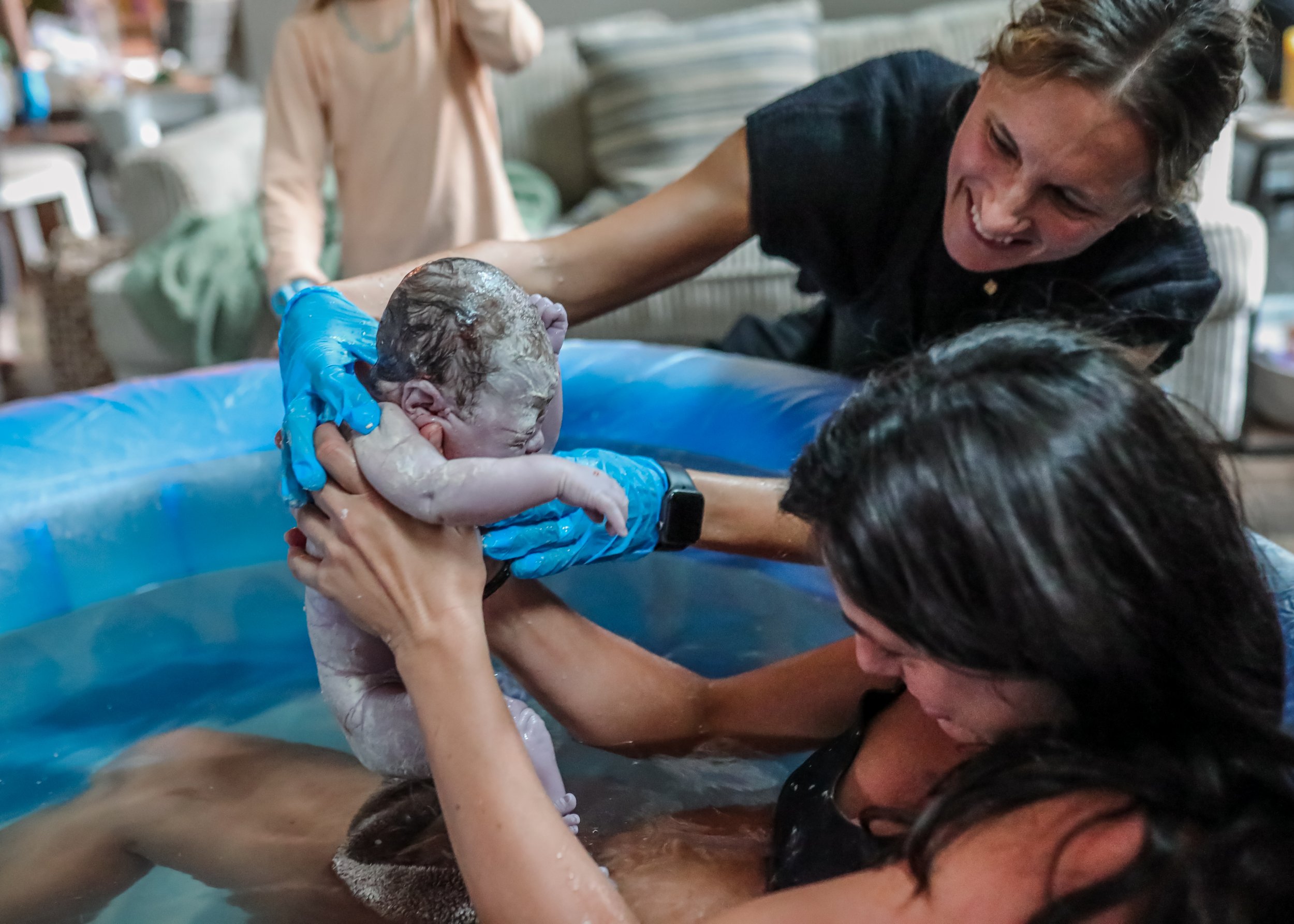In the beginning midwives
A little over a year ago, I was lucky enough to witness my first home-birth with In the Beginnings Midwives from Iola, WI. I had already been in contact with them via email, but had never had the ability to see them work or capture any of it. I have to say that coming from a mother who had worked as a labor and delivery nurse, I was quite uneducated about midwives. Since my main goal as a photographer is to highlight the strength of birthing people and how they then become parents, I wanted to learn more about the midwives and how they served their families who I may also be photographing. I asked Christie Reynolds if I could follow them around for 2-3 home-births of families who may want birth photography, but couldn’t afford it, or hadn’t thought of it. I would also like to follow them to prenatal appointments as well as postpartum to see how these appointments differ from the ones I had had at the hospital. Christie was extremely lovely and asked two families if this would work and luckily they agreed and off we went!
The first family I was honored to meet was led by Danielle, a beautiful mom of 3, soon to be 4. She had a hospital birth with her first born, and the other 2 were with Christie and the other women of In the Beginning.
The first thing I noticed about Danielle’s appointment with Christie (and May, their student midwife) was that Christie asked her about how she was. I know that sounds stupid and seems obvious, but that was never really my experience with my prenatal appointments. When I went in for my appointments, I as weighed by a nurse or MA, they measured my stomach, asked if I had any concerns for the doctor and then I waited in the room. With Christie, she asked Danielle how homeschooling was going, what was keeping her busy, the stresses in her life, and how she was feeling overall. She asked if Danielle knew her weight….which she didn’t (and that was fine) and her diet and if any foods were giving her problems. I could go on and on about their conversations. I honestly sat there in awe and with a bit of sadness. I didn’t realize prenatal care could be this ……..caring? Don’t get me wrong, I really enjoyed my experiences when I was pregnant. I liked my doctor, he answered any and all of my questions that I had (even though I didn’t know what to ask, since I didn’t know what I was doing at the time), but in hindsight, I didn’t feel that taken care of. My appointments lasted around 10 minutes and with Christie, Danielle’s appointment was at the 40 minute mark before they even listened to a heartbeat or had her lie down. I was seriously dumbfounded. There was no feeling of “turn-em-and-burn-em”…….if you’ve ever been a waitress, you know what that means.
Maybe Christie knew Danielle really well and therefore gave her more time? Maybe they’re friends outside of the whole pregnancy thing?
Then I met Laura who was doing a home-prenatal visit with Chesney in Wausau. Laura, same as Christie, talked with Chesney for about 40 mins before doing any sort of a physical exam. Wyatt, Chesney’s son, was very interested in “helping” to hear the baby’s heartbeat and Laura was more than happy to oblige. The immense care taken to make every member of the family feel informed and welcome in the birthing space is what I think makes these women, not only invaluable to your birthing experience, but highly underrated.
While watching and learning from these women after almost a year, it had me wondering why on earth more people don’t go with midwives and why there is such a stigma behind it?
Up until the 1940s, 75% of the births in the United States were born with a midwife. You read that right…..75%!
So why the change? Racism is one of the reasons….shocking I know *insert eyeroll….as well as lots of other stupid bullshit if you ask me….and you didn’t but you’re still reading, so here you go.
According to the Center of Women’s Health:
Several important milestones happened in the early part of the 1900s that had a profound impact on midwifery:
The 1910 Flexner Report recommended hospital deliveries and the abolition of midwifery. The study has since been recognized for its racist, sexist, and classist approach to medical education. ……….like I said….bullshit.
“Twilight sleep” was introduced in 1914, an amnesiac given to women preventing any memories of giving birth.
In 1915, Dr. Joseph DeLee – a prominent obstetrician – called pregnancy and childbirth “dangerous” and “evil.” Dr. DeLee promoted the use of forceps, sedatives, ether, and other interventions that needed hospital-level care. He argued that midwives were incompetent.
The Department of Indian Affairs passed legislation that moved births from the home to the hospital.
The Shepphard-Tower Infancy and Protection Act became a federal law in 1921. It encouraged states to develop their own maternal and child health legislation. Before these changes, lay midwives practiced mostly without restrictions. The new laws severely reduced their practice in many states. For example, Alabama began requiring all midwives to obtain a license, then later required nurse-midwives to practice only in hospitals. These changes prevented 150 “granny midwives” from practicing across the state practically overnight. ……….. Alabama continues to cause problems, don’t they?
Okay. I plan on doing a whole series on midwives, the demise of midwives, and how, especially after covid, they’re coming back in full force! But for now, let’s get back to the amazingness of In the Beginning midwives.
I have been able to witness them at 4 births. Four different families, four different locations, times, durations, etc. At each labor and delivery…..there was one main take away: Giving Space.
*photo of Christie “giving space” at the home-birth of Henry
When I have watched the 6 home-births progress (2 by other midwives), the midwives gave the birthing person and their support, space. Space to move. Space to breathe. Space to just progress in the manor they were comfortable with. Christie, Laura and Korina check in every once and awhile, checking the baby’s heartbeat, asking questions, giving advice…..and that’s it. They have such faith and confidence in their clients because they know that their clients are prepared for this. The midwives have educated them, listened to them, put that plan in place WITH them.
So much of this post is about me being highly uneducated when it was time to birth my own boys. I took the 6ish hour birthing course with my husband on a Saturday a couple of months before I was due, and that was it. I didn’t know I could say no. I didn’t know I didn’t NEED to have my cervix checked all the time. I didn’t know I could move around and birth on all fours if I wanted. I didn’t know …….hardly anything.
If you’re pregnant or plan on becoming pregnant, I highly recommend at least interviewing the idea of having a home-birth. Do your research! Ask the questions! These three amazing women have collectively been helping babies be born for over 45 years. They know what they’re doing.
As of 2021, 12% of all births in the United States were born with a midwife. That is one lucky 12%.
At the birth of Tulsi, Korina adding a bit of hot water to the birthing pool
I will be continuing to educate myself and therefore making several blog posts about it. Follow along to be just as fascinated as I have become! ……and we haven’t even talked about postpartum visits yet!




















